

Musical Cognition. Musical Creativity and the Brain. What can studying musicians tell us about motor control of the hand? - Watson - 2006 - Journal of Anatomy. 9 Psychoacoustic Tricks. When talking about improving the perceived quality of our productions and mixes, its easy to focus mainly on the technology we use, or the layout and acoustic treatment of our listening environment.
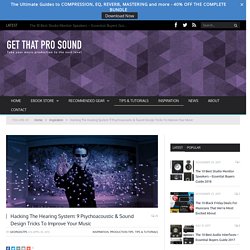
It’s easy to forget that just as important as our software, equipment and studio is what happens to the signal after all of that, once the sound has made it into our internal hearing system – our ears and brains – and how that sound is actually experienced. So that’s what this article is about: some tips and tricks for operating and manipulating your listeners built-in ‘equipment’! Music To Your Ears. How We Hear Pitch. When two sounds happen very close together, we hear them as one.

This surprising phenomenon is the basis of musical pitch — and there are lots of ways to exploit it in sound design. Emmanuel Deruty Films and television programmes consist of a series of individual still images, but we don't see them as such. Instead, we experience a continuous flow of visual information: a moving picture. Ambience and Interactivity. [We are currently having a few problems with page formatting and embedding SoundCloud links, please bear with us until we fix it!]
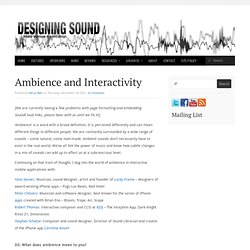
‘Ambience’ is a word with a broad definition. It is perceived differently and can mean different things to different people. We are constantly surrounded by a wide range of sounds – some natural, some man-made. Practical Synthetic Sound Design. Nine Components of Sound. Why Your Brain Craves Music. If making music isn’t the most ancient of human activities, it’s got to be pretty close.
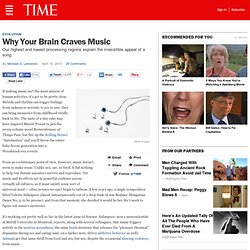
Melody and rhythm can trigger feelings from sadness to serenity to joy to awe; they can bring memories from childhood vividly back to life. The taste of a tiny cake may have inspired Marcel Proust to pen the seven-volume novel Remembrance of Things Past, but fire up the Rolling Stones’ “Satisfaction” and you’ll throw the entire baby-boom generation into a Woodstock-era reverie. From an evolutionary point of view, however, music doesn’t seem to make sense.
Unlike sex, say, or food, it did nothing to help our distant ancestors survive and reproduce. Yet music and its effects are in powerful evidence across virtually all cultures, so it must satisfy some sort of universal need — often in ways we can’t begin to fathom. (MORE: Your Brain on Sesame Street: Big Bird Helps Researchers See How the Brain Learns) Psychoacoustics. How The Ear Works. The most important pieces of hardware in any studio are the ones on the sides of your head.

We look at the amazing journey your music makes on its way to the brain... Emmanuel Deruty In this article, we're going to have a close look at the tool we all use every day: the ear. This small organ has quite a few surprises in store for us. We' see that it's literally crammed with equalisers and dynamic compressors, including a multi‑band one. Note that this article won't attempt to cover psychoacoustics in its entirety. The Recording Studio In Your Head. Acoustics and Psychoacoustics. Inaudible High-Frequency Sounds Affect Brain Activity: Hypersonic Effect. Psychoacoustics: Where Sound Meets Your Brain. In this article, we’re going to have a close look at the tool we all use every day: the ear.

This small organ has quite a few surprises in store for us. We’ll see that it’s literally crammed with equalizers and dynamic compressors, including a multi‑band one. It even includes an extremely efficient filter bank, as well as a highly sophisticated analogue‑to‑digital converter. Armed with this knowledge, sometimes referred to as ‘psychoacoustics’, we’ll discover numerous practical consequences for music production. The Physical Principles of Sound. An introductory guide to the physical properties of sound and a basic introduction to the acoustics of enclosed spaces.
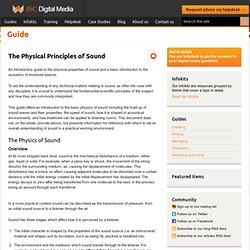
To aid the understanding of any technical matters relating to sound, as often the case with any discipline, it is crucial to understand the fundamental scientific principles of the subject and how they are commonly interpreted. This guide offers an introduction to the basic physics of sound including the build up of sound waves and their properties, the speed of sound, how it is shaped in acoustical environments, and how treatment can be applied to listening rooms. This document does not, on the whole, provide advice, but presents information for reference with which to aid an overall understanding of sound in a practical working environment. Measuring sounds in Three Dimensions.
To explain how we can locate sound sources fixed in space from any observing location, we must diverge a little and consider how sound waves from live sources actually behave.
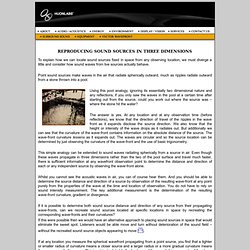
Point sound sources make waves in the air that radiate spherically outward, much as ripples radiate outward from a stone thrown into a pool. Using this pool analogy, ignoring its essentially two dimensional nature and any reflections, if you only saw the waves in the pool at a certain time after starting out from the source, could you work out where the source was – where the stone hit the water? The answer is yes. Psychoacoustics: Faking the Space. When building the space that sounds occupy, it may sometimes seem like overkill to load up those DSP hungry (though wonderful) reverb plug-ins. They can be a pretty big load when it comes to even the mildest amount of spatialization, and it can also be time consuming to configure one to emulate an outdoor space.
I thought it would be worth sharing a trick of mine for both situations. Creating the Spaces of Ambience. Guest contribution by Michael Theiler (Kpow Audio) Situating an Ambience When creating ambiences for games (this applies equally to film), I am striving to make them blend into the background and not mask any important in game sounds.
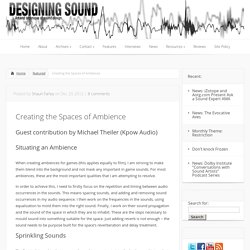
Training the Musical Brain. Tonight is opening night.

I can already imagine it: the theatre is full. From the wings I can hear muted pre-show conversations, the rustle of programs, laughter. The house lights go down, and the tension in my stomach tightens; my intestines feel like knots. I start to sweat, and hope my shaking is not visible. As the opening music begins, I walk onto the stage. Auditory Perspective: Putting The Audience In The Scene. (CC BY 2.0) OiMax By Karen Collins Adapted from a forthcoming article in Animation: An Interdisciplinary Journal. Music Psychology Dr Victoria Williamson. Mood & Music. Musical preference is unique to the listener. The Real Neuroscience of Creativity. So yea, you know how the left brain is really realistic, analytical, practical, organized, and logical, and the right brain is so darn creative, passionate, sensual, tasteful, colorful, vivid, and poetic? Musical Cognition. Clinical Neuroscience-Research Grants.
Hierarchical Structures in Music. Hierarchical Structures in Music The hierarchical structure within music, especially within rhythmic passages and melodic contours, is a well-known phenomenon. Characteristics of Musical Keys. "Today many musicians claim to hear the different characteristics very clearly, and associate them with the emotional quality of the music.